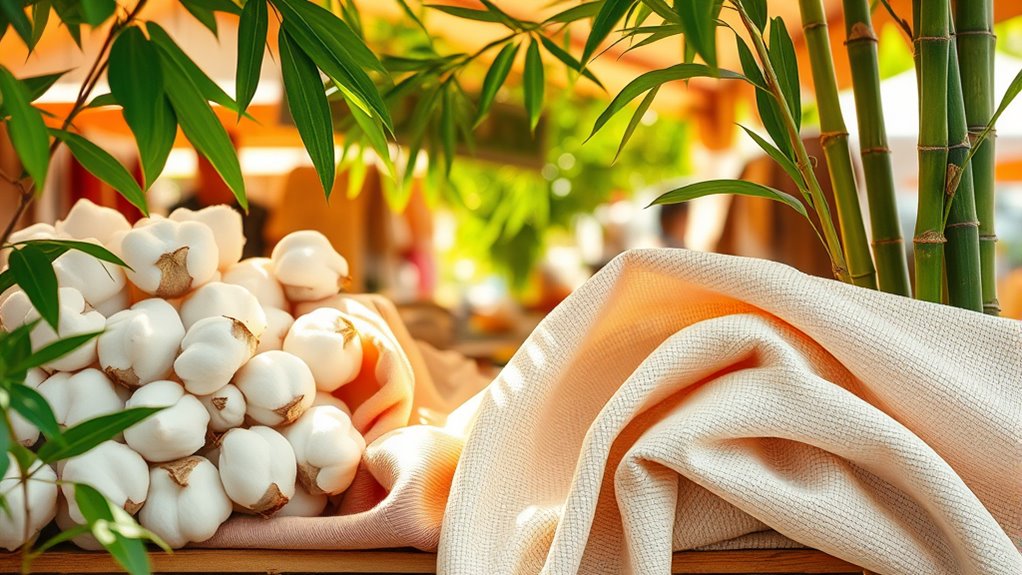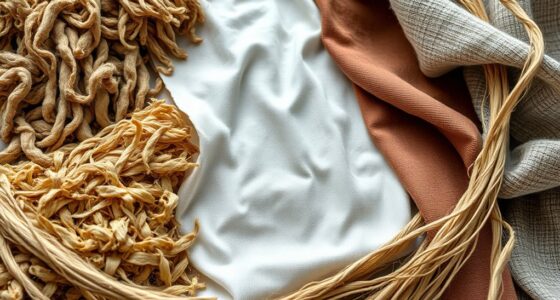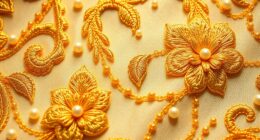Eco-friendly fabrics like organic cotton, bamboo, hemp, and Tencel offer sustainable options that reduce environmental impact. They’re grown using fewer chemicals, require less water, and are often biodegradable. These materials are durable, long-lasting, and supportive of eco-conscious practices, helping you minimize your ecological footprint. If you want to discover how to choose the most sustainable fabrics from organic cotton to bamboo, there’s plenty more to explore below.
Key Takeaways
- Eco-friendly fabrics like organic cotton, bamboo, hemp, and Tencel are sustainable alternatives that reduce environmental impact.
- These materials use less water, chemicals, and energy during cultivation and production, supporting eco-conscious practices.
- They offer durability, softness, and long-lasting wear, promoting a sustainable fashion lifecycle.
- Certification labels such as GOTS, OEKO-TEX, and Fair Trade verify ethical and eco-friendly manufacturing standards.
- Choosing these fabrics encourages responsible consumption and supports environmentally and socially sustainable industries.
Understanding Eco-Friendly Fabrics and Their Impact
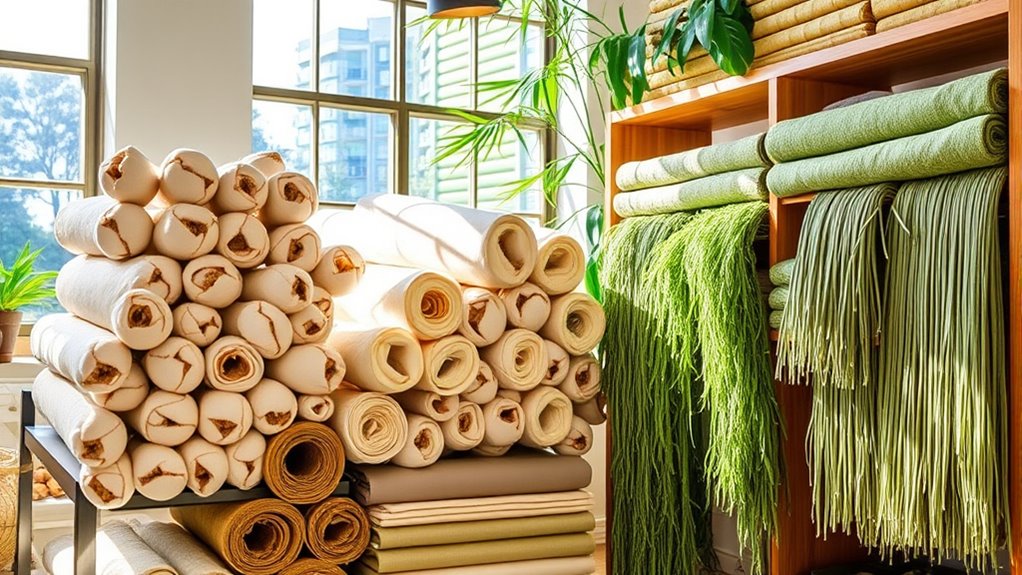
Have you ever wondered how eco-friendly fabrics make a difference? These fabrics are designed to reduce environmental impact compared to conventional materials. They often use sustainable resources, lower water consumption, and minimal chemicals during production. Choosing eco-friendly fabrics helps conserve natural resources, reduce pollution, and lower greenhouse gas emissions. They also support fair labor practices and promote healthier ecosystems. By opting for these textiles, you’re making a conscious choice that benefits both the planet and the people involved in manufacturing. The impact extends beyond just reducing waste; it encourages innovation in sustainable farming and production methods. Additionally, selecting sustainable practices that reflect a commitment to sustainability can reinforce your eco-conscious lifestyle. Ultimately, when you select eco-friendly fabrics, you’re contributing to a more sustainable future and encouraging the fashion industry to adopt greener practices.
Organic Cotton: Softness and Sustainability
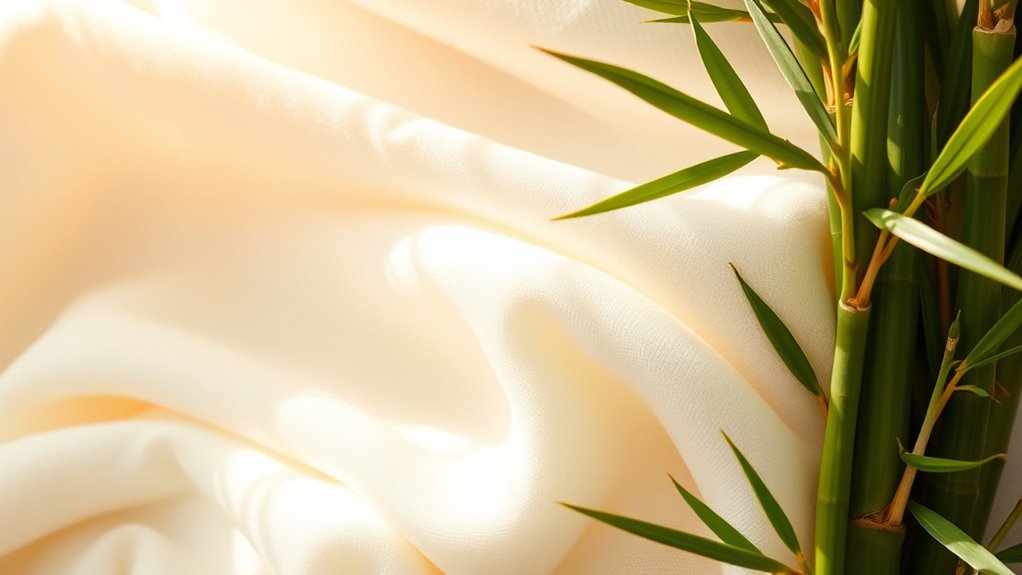
Organic cotton stands out as a leading eco-friendly fabric because it combines exceptional softness with sustainable farming practices. When you choose organic cotton, you’re opting for a crop grown without synthetic pesticides or fertilizers, reducing environmental harm and supporting healthier ecosystems. This method also conserves water compared to conventional cotton farming. As a result, your clothing feels gentle against your skin while minimizing your ecological footprint. Organic cotton is naturally breathable and durable, making it perfect for everyday wear. Its softness doesn’t fade over time, so your garments stay comfortable longer. By selecting organic cotton, you contribute to a more sustainable fashion industry and promote practices that protect the planet for future generations. It’s a simple choice that makes a meaningful difference. Additionally, choosing organic cotton can help prevent misleading marketing that sometimes clouds consumer understanding of eco-friendly fabrics. Incorporating organic cotton into your wardrobe encourages sustainable textile practices and supports environmentally responsible farming methods. Using organic cotton also reduces the use of harmful chemicals, benefiting both farmers and consumers. This shift is further supported by increased consumer awareness and educational initiatives, which promote eco-conscious choices in the fashion industry. Furthermore, adopting organic cotton can inspire broader shifts towards eco-conscious manufacturing, fostering a healthier planet.
Bamboo Fabric: A Versatile and Eco-Conscious Choice
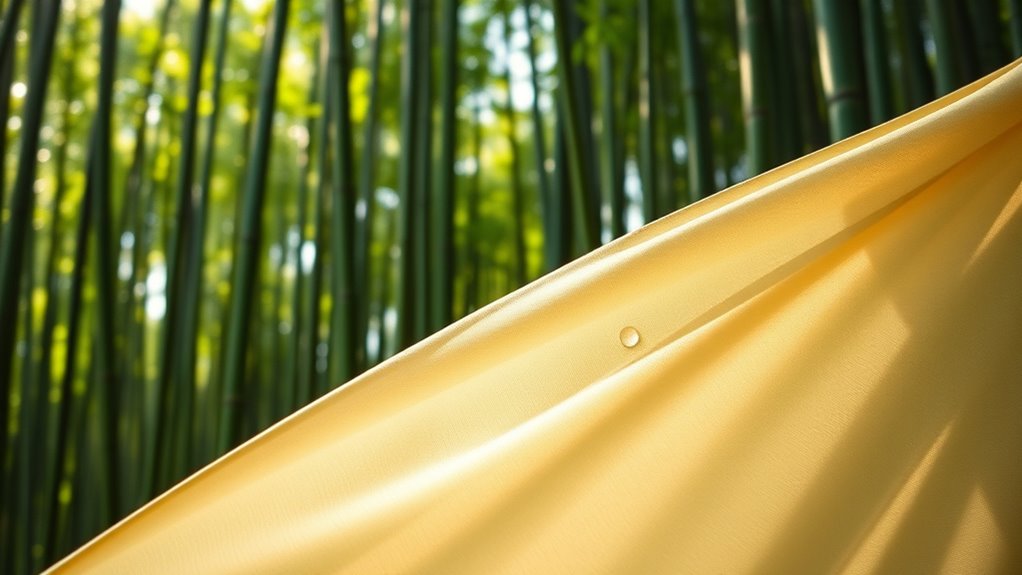
Bamboo fabric has gained recognition as a versatile and eco-conscious material because it grows rapidly without the need for harmful chemicals. This fast growth makes bamboo a highly renewable resource, reducing environmental impact. When processed into fabric, bamboo offers a soft, breathable, and moisture-wicking material perfect for clothing, bedding, and towels. It also has natural antibacterial properties, helping to keep items fresh longer. Plus, bamboo cultivation requires less water and pesticides compared to other crops, making it a sustainable choice. You’ll find bamboo fabric to be durable and easy to care for, which adds to its appeal. Its eco-friendly production process minimizes waste and energy use, aligning with your desire to make environmentally responsible choices. Additionally, advancements in AI-driven sustainability are helping optimize bamboo farming methods for even greater environmental benefits. Sustainable farming practices further enhance bamboo’s reputation as an eco-friendly material. Incorporating risk management in the production process ensures quality and sustainability are maintained throughout. Moreover, innovations in fiber processing contribute to improved fabric quality while maintaining environmental standards. Overall, bamboo fabric combines versatility, comfort, and sustainability in one practical package.
Hemp and Linen: Durable Alternatives for Eco-Friendly Fashion
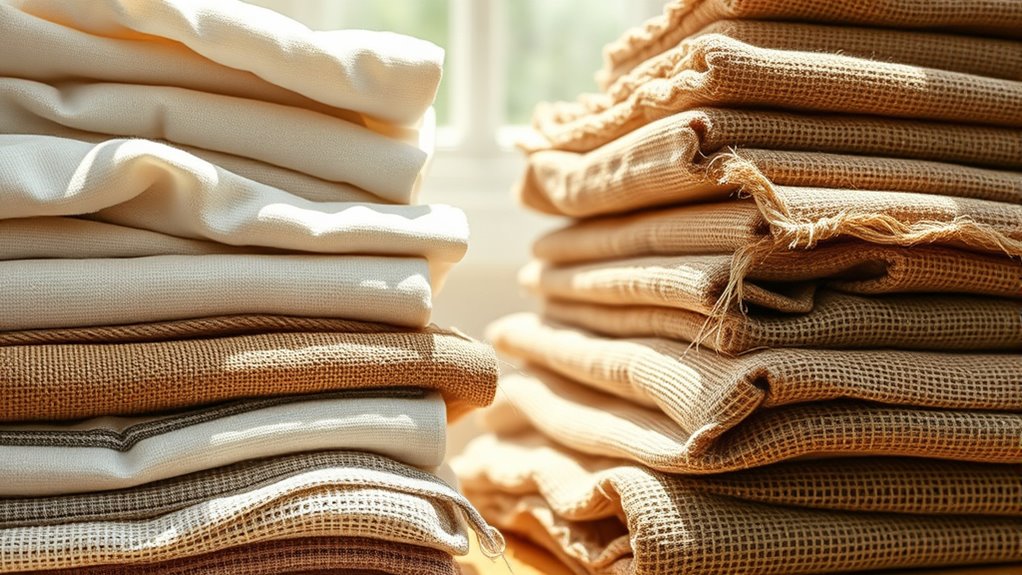
Hemp and linen are known for their exceptional strength and long-lasting durability, making them ideal for eco-friendly fashion. Their sustainability benefits come from being fast-growing crops that require minimal water and no harmful chemicals. Choosing these fabrics means you get clothing that’s both resilient and better for the planet. Additionally, their low environmental impact ensures that producing and caring for these textiles remains eco-conscious. Proper care, such as regular vacuuming, can help extend the lifespan of garments made from these natural fibers. Incorporating sustainable agriculture practices can further reduce the ecological footprint of cultivating these materials, emphasizing the importance of environmentally responsible farming methods. Moreover, selecting biodegradable fabrics supports a circular lifecycle, minimizing waste and pollution.
Strength and Longevity
While many eco-friendly fabrics prioritize sustainability, their strength and durability are equally important for long-lasting fashion. Hemp and linen stand out because they’re naturally tough fabrics that hold up over time. You’ll find that they resist tearing and wear better than some synthetic options. These fabrics can handle frequent washing without losing their integrity, making them ideal for everyday use. Plus, their fibers become softer with each wash, increasing comfort without sacrificing strength. When you choose hemp or linen, you’re investing in clothing that lasts longer, reducing the need for replacements. They’re resilient choices that stand up to the test of time. Additionally, ongoing research in machine learning technology is helping improve fabric manufacturing processes, leading to even more durable and eco-friendly textiles. This innovation is contributing to the ongoing development of sustainable textiles, ensuring a greener future for fashion. Furthermore, understanding fiber properties helps in selecting fabrics that offer both durability and environmental benefits, which is crucial as consumer awareness continues to grow.
Sustainability Benefits
Choosing durable fabrics like hemp and linen not only guarantees your clothing lasts longer but also offers significant environmental advantages. Both materials require fewer resources during cultivation, with hemp needing little water and no pesticides, making it highly sustainable. Linen, derived from flax, grows quickly and improves soil health, reducing the need for chemical fertilizers. These fabrics are biodegradable, reducing waste in landfills. Their low energy manufacturing processes further lessen carbon footprints. Hemp and linen also flourish naturally without intensive farming practices, conserving water and land. By choosing these eco-friendly options, you support sustainable agriculture and reduce your overall environmental impact. Their durability means fewer replacements, cutting down on textile waste and resource consumption, making them smart choices for eco-conscious fashion lovers.
Tencel and Lyocell: Innovating Sustainable Textiles
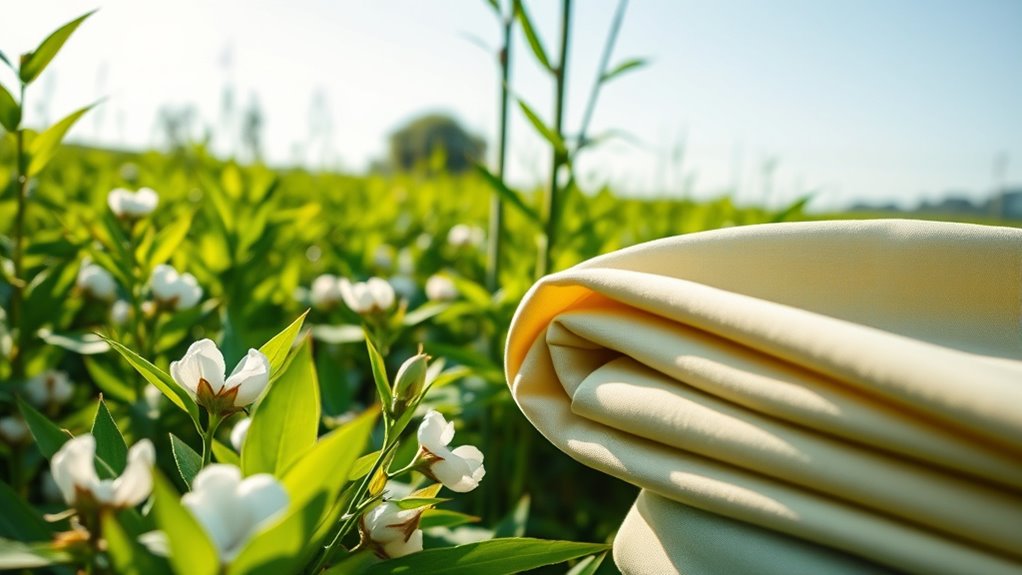
Tencel and Lyocell are leading the way in sustainable textiles by offering eco-friendly alternatives to traditional fabrics. Made from sustainably harvested wood pulp, these fibers are produced through a closed-loop process that recycles water and solvents, minimizing environmental impact. They’re soft, breathable, and biodegradable, making them perfect for eco-conscious choices. You’ll find Tencel and Lyocell in everything from clothing to home furnishings, thanks to their versatility. Plus, their production uses less water and energy compared to conventional fabrics, reducing your carbon footprint. Whether you’re shopping for a new shirt or bedding, choosing these fibers supports sustainable innovation. Here’s what makes them stand out:
- Renewable raw materials
- Low water and energy use
- Biodegradable and compostable
- Comfortable and durable
- Regular manufacturing practices such as regular grooming can further enhance the longevity and sustainability of products made from these fibers.
How to Identify and Choose Truly Eco-Friendly Fabrics
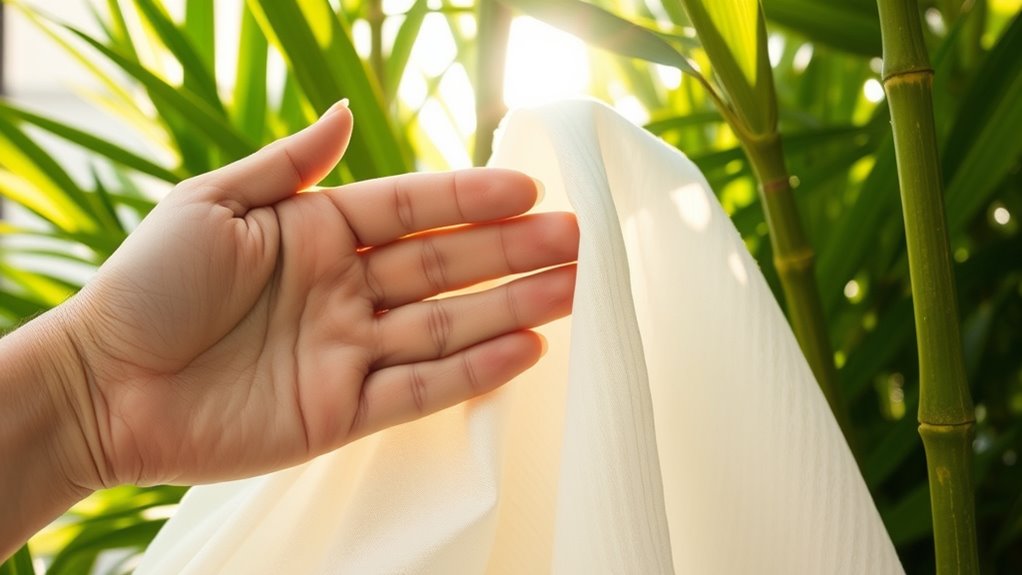
To find truly eco-friendly fabrics, start by checking certification labels like GOTS or OEKO-TEX, which verify sustainable practices. Pay attention to how the fabric is produced, since manufacturing impacts can vary widely. Additionally, researching sound design techniques used in manufacturing processes can help identify fabrics produced with minimal environmental impact. Understanding production methods can also reveal the overall sustainability of the fabric’s lifecycle. Reviewing energy consumption during production can further indicate how environmentally friendly the process is, as efficient energy use reduces the carbon footprint. Incorporating sustainable supply chain management practices can ensure that eco-friendly standards are maintained throughout the fabric’s journey from raw material to finished product. Familiarity with efficient general ledger coding can also provide insight into companies’ financial transparency regarding sustainable practices.
Certification and Labels
How can you be sure that a fabric labeled as eco-friendly truly lives up to its claims? Certifications and labels help establish a product’s sustainability. Look for reputable standards like GOTS (Global Organic Textile Standard), OEKO-TEX, or Fair Trade. These certifications ensure the fabric meets strict environmental and social criteria. Keep an eye out for labels that specify organic farming, responsible dyeing, or fair labor practices. Remember, not all eco-labels are equal—some are more credible than others. Do your research on the certifying organization to confirm their reputation. Trustworthy certifications give you confidence that you’re choosing genuinely eco-friendly fabrics, making your shopping more intentional and impactful. Additionally, understanding sustainable textile standards can help you better evaluate the authenticity of eco-friendly claims.
Material Production Impact
Understanding the environmental impact of fabric production is crucial when choosing truly eco-friendly materials. Look beyond labels and research how fabrics are made. For example, conventional cotton requires massive amounts of water and pesticides, harming ecosystems. Bamboo grows quickly with minimal water and no chemicals, making it more sustainable. Consider the energy and water used during manufacturing—producing recycled fabrics or those made with low-impact processes reduces your footprint. Check if the production process minimizes waste and pollution. Eco-friendly fabrics often involve environmentally conscious dyeing techniques and renewable energy sources. By understanding these factors, you can make informed choices, selecting fabrics that truly prioritize sustainability. Ultimately, evaluating a fabric’s production impact helps you support brands committed to reducing environmental harm.
Frequently Asked Questions
Are Eco-Friendly Fabrics Suitable for All Skin Types?
You might wonder if eco-friendly fabrics suit all skin types. Generally, they’re a great choice because they’re often made from natural, breathable materials like organic cotton or bamboo, which are gentle on sensitive skin. However, everyone’s skin reacts differently, so it’s smart to check for any allergies. Test new fabrics on a small skin area first, and choose those labeled hypoallergenic if you have concerns.
How Do Eco-Fabrics Compare in Cost to Conventional Textiles?
You might notice that eco-fabrics often cost a bit more than conventional textiles. That’s because sustainable materials like organic cotton and bamboo require more eco-friendly farming practices and ethical production, which can drive up prices. While the upfront cost is higher, you’re investing in better environmental impact and durability. Over time, this often balances out, making eco-friendly fabrics a worthwhile choice for those who value sustainability and quality.
Can Eco-Friendly Fabrics Be Recycled or Reused Easily?
You might wonder if eco-friendly fabrics are easy to recycle or reuse. Many are designed with sustainability in mind, making them more recyclable than traditional textiles. Materials like organic cotton and bamboo can often be repurposed or composted, depending on their processing. However, blends or fabrics treated with chemicals can pose challenges. Overall, choosing eco-fabrics encourages a circular approach, reducing waste and extending their life cycle.
What Are the Environmental Trade-Offs of Producing Bamboo Fabric?
You wonder about the environmental trade-offs of producing bamboo fabric. While bamboo grows quickly and requires less water and pesticides, the process of turning it into fabric often involves chemical treatments that can harm ecosystems. Additionally, some manufacturing methods release pollutants. So, although bamboo is renewable, you should consider these trade-offs, and look for brands that use eco-friendly processing methods to minimize environmental impact.
How Long Do Eco-Friendly Fabrics Typically Last With Proper Care?
Imagine your favorite eco-friendly shirt as a garden that flourishes with proper care. Generally, eco-friendly fabrics like organic cotton and bamboo last 3-5 years with proper washing and storage. For instance, bamboo can be surprisingly durable, often outlasting synthetic alternatives when well-maintained. Your commitment to gentle washing and avoiding harsh chemicals helps these fabrics stay vibrant, ensuring your sustainable wardrobe remains functional and stylish for years to come.
Conclusion
Choosing eco-friendly fabrics is like planting seeds for a greener future. By understanding the differences — from organic cotton to bamboo — you become a steward of the planet’s health. When you select sustainable materials, you’re weaving a tapestry of change, each choice a vibrant thread in the fabric of a cleaner Earth. So, next time you shop, let your conscience be your compass, guiding you toward a more beautiful, sustainable world.
